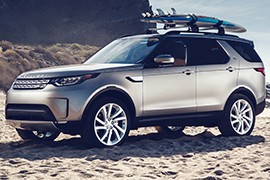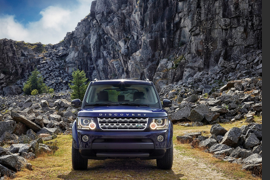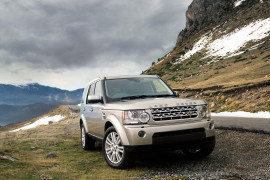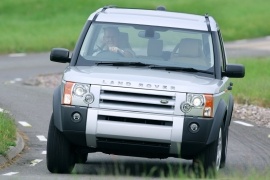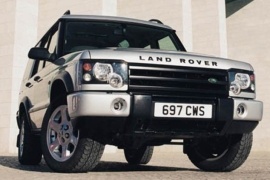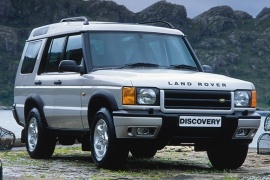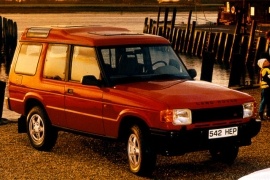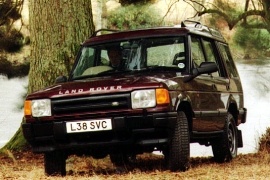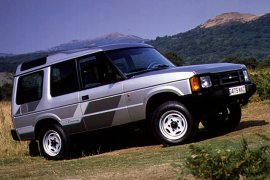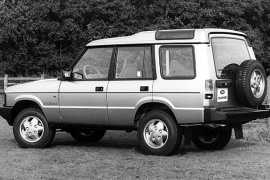LAND ROVER Discovery Models/Series Timeline, Specifications & Photos
First production year: 1990
Engines: Diesel, Gasoline
Body style: SUV (Sports Utility Vehicle)
The 2017 Land Rover Discovery was a completely new model, designed from the ground up. But, somehow, succeeded to keep the original cues of the Discovery Series I with its specific two-stage roof.
At the front, the 2017 model featured a smaller grille than on the models before. The idea behind the concept was to make the car more aerodynamic than its predecessors. That wasn't too hard since the Discovery 3 and the LR4 were basically squared. The biggest challenge was to make the car more aerodynamic but to keep its superior SUV appearance with true off-road capabilities.
Unlike most of the cars on the market, the 2017 Discovery had a small grille and a very big bumper. In the lower part, it had a silver shield and on the sides, it had air-vents for brakes cooling. The roofline had a small ascending slope over the C-pillar to improve the headroom for the rear passengers. The dynamic look was enhanced by the standard 19" wheels. As an option, light-alloy wheels of up to 22" in size were available.
Inside, the Discovery took some amenities from its Jaguar siblings, most noticeable being the infotainment unit that featured a dual-screen view. Like the generations before it, the 2017 Discovery had an option of up to 7 seats. Due to vehicle size, the last row was suitable even for adult passengers, not only for toddlers.
The off-road capabilities were kept at the Land Rover standards, with a wading depth of up to 850 mm (33.5"). The ground clearance of up to 22 cm (8.6") made the car very capable of untraced paths.
Despite using the LR4 name, the 2013 Discovery was more of a significant facelift for the third generation of the well-known Land Rover model than a completely new vehicle.
After Ford sold the Land Rover brand to Tata Industries, the Indian holding invested a big chunk of money into the R&D department. New engines, new options, and new transmissions were adopted to make the Discovery a much better car. And, somehow, it succeeded.
With a headlights design inspired by its bigger brothers, the LR4 was the last step before a new model. It still kept the same body structure with an aluminum, unibody shape. The two-heights roofline from the first generation was kept. Despite the general trend of making the off-road vehicles looks more aerodynamic, the LR4 was still shaped with an ax and trimmed with a chisel.
The interior was heavily modified, but it still kept some buttons and shapes from various Ford models. On the center console, the automatic transmission selector was a rotary knob, just like those found on the Jaguar XF. Before that, a conventional lever was used instead. The infotainment unit was placed higher on the center stack, and, if that wasn't ordered, a big empty box was found there. The LR4 kept the same seating configuration, which allowed them to offer room for up to seven passengers.
Under the hood, the LR4 was offered with a choice of two 3.0-liter engines, mated to a standard 8-speed gearbox.
After breaking the ties with Ford, Land Rover tried to improve as fast as possible, draining money from its new owner, Tata Motors from India.
While it didn't have enough resources to change the lineup completely, the British automaker could upgrade what it already had on the assembly lines, naming the Discovery lineup. In 2009, the automaker introduced the facelifted version and named it LR4. It had to upgrade the SUV since Europe was ready to implement the Euro 5 emission standards, which the Discovery couldn't achieve with its previous engines. In addition, the automaker also refreshed the car's look.
The front fascia featured new headlights with illuminated rings around the high- and low beams. Also, the headlamps' shape was altered and featured a round extension into the grille's area. The automaker installed new foglamps on the bumper in a retracted, protected position. From the sides, the car kept its overall appearance, with the two-step roof line specific for all Discovery models since then. At the back, Land Rover installed a new set of taillights.
Inside, the automaker drastically improved the instrument cluster. Instead of the older dials and gauges carried over from Ford, the British carmaker placed a 5" LCD showing various onboard computer data. Another improvement over its predecessor was the center stack slightly tilted toward the driver's seat. Thus, it improved access to the controls for the Terrain Response knob, which was moved to the front of the center console. In addition, the cup holders were installed in a more convenient location. Finally, the interior illumination was made with LEDs.
Under the skin, the car was improved in terms of fuel efficiency and emissions. In addition, it complied with the ULEV2 standards. In Europe, the 3.0-liter V6 turbo-diesel was the new star of the range, offering similar performance as the former 3.6-liter V8 oil burner.
The third generation of the Discovery was launched in 2004 and the much-awaited upgrade was kind of a disappointment. The LR3 designation was for the U.S. market, continuing the LR2 name, which was assigned to the Land Rover Freelander 2. While the first two generations had live axles, the LR3 was introduced with all-wheel independent air-suspension. That allowed the vehicle to increase or decrease its ground clearance but raised doubts about its durability. The second generation of the Land Rover Discovery was kind of a disappointment due to reliability issues.
Under Ford ownership, this new generation came with special new bodywork, a mix between a monocoque body and a body-on-frame. The result was a heavier vehicle then a unibody and not as stiff as a chassis-based vehicle.
But the biggest enhancement is the introduction of the Terrain Response system, which set all the car's systems (gear, transfer ratio, and differentials) according to the nature of the terrain. It was able to send the most torque to the wheels that have the highest traction and it wasn't just a marketing slogan. It really worked.
The LR3 had a V8 AJ41 engine coupled as standard with a six-speed automatic and a two-speed transfer case. A computer-controlled progressively locking central differential ensured traction was retained in tough conditions. A similar differential was available on the rear axle to aid traction.
While the second generation of the Discovery was marketed as evolution more than a revolution, the 2002 model was just a minor facelift.
In 1998, Land Rover thought that electronics could replace the old-school mechanical parts that transformed a regular 4x4 into a serious off-road vehicle. Shortly after, it noticed the hard way that a computer-controlled traction system cannot replace the locking differentials.
For 2002, Land Rover introduced a series of modifications that changed the car's look and added more comfort features inside. On the outside, the new headlights offered a multi-lamp arrangement while its predecessor featured plain, squared units. The bumper was also revised, and, depending on the trim level, it featured a pair of fog-lights.
Inside, the carmaker was keener for details and installed better seats and new upholstery options. Like its predecessor, it offered with an option for seven seats, but only for vehicles fitted with rear air suspension. In the safety department, Land Rover added side airbags and an all-leather interior. The Active Cornering Enhancement system (ACE) acted as an anti-roll-over one. It used the brake system to balance the vehicle, and, due to the electronically controlled stabilizer bars, it reduced body-roll.
On the technical side, the most significant improvement was the reintroduction of the locking center differential. The base version had it available as an option, while it was standard on the HS and HSE versions.
In the autumn of 1998, Land Rover introduced the fresh, brand-new second generation of the Discovery, offering more than just a rugged off-roading vehicle.
At that time, Land Rover said that the Discovery sports an "Evolution that hides a revolution," and in terms of design, they were absolutely right. At first sight, not many people could distinguish the Disco II from its predecessor. And yet, despite using the many underpinnings from the 1970 Range Rover, there were significant changes both on the interior and exterior, including the drivetrain.
On the outside, the SUV kept the flat front fascia with rectangular headlights, although they looked bigger than on its predecessor. Also, the hood received a slight cut above the headlamps, and its front edge was not straight anymore. Discovery II also sported a plastic, body-colored bumper that integrated the fog lights. From its profile, the unique two-step shape of the roof was kept, and so were the upper rear glass areas. Yet, the grab handles for the doors were not upgraded to flush ones. Finally, at the back, the side-hinged door also served as a support for the spare wheel.
The interior was revolutionary compared with its predecessor. While it still retained the utilitarian appearance, it was more refined. For instance, the low-mounted dashboard allowed occupants to enjoy a panoramic view through the generous windshield. At the same time, the center stack hosted the controls for the HVAC system and the stereo that was mounted right underneath it. The wide center console was configured to host two cup holders, the gear selector for the gearbox, and the lever for the transfer box. A pair of wide bucket seats fitted with individual armrests provided a comfortable ride. In the back, three passengers could sit on the 60/40 split-folding bench. Finally, as an option, Land Rover provided two front-facing jump seats in the trunk area.
Under the hood, the Discovery came fitted with an in-house developed 2.5-liter, inline-five turbo-diesel. The only option for a gasoline unit was a new 3.9-liter V8. Power went in all corners via three differentials.
In 1994, Land Rover improved the Discovery range in both versions: the 3- and the 5-doors. It brought several modifications to comply with the new safety and emissions regulations.
Land Rover didn't have the habit of doing a facelift to its vehicles. Usually, they just named-it as a new series. That's why, on some markets, the 1994 Discovery was named Discovery II, even though it was just a mid-life cycle impulse that brought external and internal modifications.
Designed as a premium SUV, the Discovery offered an excellent mix between comfort, price, and off-road abilities. It was offered in both versions, with three or five doors, to make the car more appealing for those who tried to take them into serious off-road adventures but to pay lower taxes. Some versions were registered as utility vehicles in the U.K. since they had only two doors. The 1994 model featured bigger headlights with an angled upper inbound corner and two sets of taillights in the rear, but only one was functional.
Inside, Land Rover offered a good front room for the Discovery's occupants. The two-door Discovery 1 had short front doors that made access to its rear difficult, but once passengers were installed, they were granted enough room. Not to mention the pop-out windows for them, for a breath of fresh air.
Under the hood, Land Rover dropped the older engines and adopted a new, 2.5-liter, direct-injection and turbocharged diesel. The carmaker offered the car with a 3.9-liter V8 gasoline unit. Both versions were mated to a 5-speed manual gearbox and a low-range transfer box.
It was the last stint for the first generation of the Discovery, and Land Rover improved the aged SUV in many areas, preparing it for the next generation.
The British carmaker didn't make that many changes over the years to the Discovery as it did in 1994, and on some markets, it even named it Discovery II, even though it was just a refresh that brought external and internal modifications.
Land Rover offered the Discovery in a three- or five-door configuration. The latter version was more suitable for families. The 1994 model featured bigger headlights with an angled upper inbound corner and two sets of taillights in the rear, but only one was functional. A set of side-steps was offered as an option to ease ingress and egress to the car.
The Discovery also received some upgrades on the interior in terms of safety. For specific markets, and as an option, the carmaker installed either driver or dual-airbag on the redesigned dashboard. The carmaker installed either textile or leather upholstery depending on the trim level. At the back, the split-folding rear bench increases the trunk area.
Under the hood, Land Rover dropped the older engines and adopted a new, 2.5-liter, direct-injection and turbocharged diesel. In addition, the carmaker offered the car with a 3.9-liter V8 gasoline unit. Both versions were mated to a 5-speed manual gearbox and a low-range transfer box.
Land Rover made a stunt move and introduced a more affordable version for the Range Rover when introducing a three-door Discovery on the market in 1990.
Like the Range Rover, the Discovery started its career as a three-door only off-road vehicle. In the following year, it added another set of doors for the rear passengers. But it was the first version that conquered the hearts (and pockets) of those who liked a comfortable family vehicle but with outstanding off-roading skills.
Even though the aluminum was already more expensive than the regular steel panels, Land Rover still used it. At the front, the carmaker installed rectangular headlights and corner-mounted turn signals to comply with the latest road legislation from Europe and U.S. On the sides, the doors featured flush-mounted door handles, and behind them, Land Rover added a large side window between the B-pillar and the thick C-pillar. A third glass area provided more natural light in between the C- and the D-pillars. Finally, the British designers created a two-step roof with a raised area above the trunk.
Inside, there was a modern interior with front bucket seats that tilt-forward to make room for the rear passengers. For the driver, the carmaker installed buttons on the sides of the instrument cluster. For a comfortable ride, there was an option for two sunroofs on top of the three-door Discovery. To get in the rear seats, the front ones tilted and slid forward.
But the essential part of the car was under the bodywork. Its coil-springs in all corners with live axles ensured a long suspension travel and comfortable ride. Land Rover installed an all-wheel-drive system with a locking center differential and a two-speed transfer case. Under the hood, the carmaker offered a choice of two engines: a 3.5-liter gasoline V-8 and a 2.5-liter turbo-diesel. The former was developed especially for the U.S. market, while the latter was the top-seller on the European continent. For specific countries, such as Greece, Italy, and Portugal, Land Rover provided the vehicle with a 2.0-liter gasoline engine.
Land Rover introduced the Discovery lineup in 1990 as a more affordable version for the Range Rover and a more comfortable option than the rugged Defender.
While it started its career as a three-door affair, the British carmaker understood that a five-door version had to be offered on the market. Thus, it was more appealing to those who looking for a high-rider, premium family vehicle. But despite its decent road behavior, the Discovery proved to be very effective on trails. Moreover, it was promoted during the Camel Trophy years.
Even though the aluminum was already more expensive than the regular steel panels, Land Rover still used it. At the front, the carmaker installed rectangular headlights and corner-mounted turn signals to comply with the latest road legislation from Europe and U.S. On the sides, the doors featured big windows and flush-mounted door handles. Behind them, Land Rover added a third side glass area between the C-pillar and the thick D-pillar. Finally, the British designers created a two-step roof with a raised area above the trunk.
Inside, there was a modern interior with front bucket seats at the front and a bench for three in the back. For the driver, the carmaker installed buttons on the sides of the instrument cluster. Furthermore, the split-folding rear seats increased the already big trunk space.
But the essential part of the car was under the bodywork. Its coil-springs in all corners with live axles ensured a long suspension travel and comfortable ride. Land Rover installed an all-wheel-drive system with a locking center differential and a two-speed transfer case. Under the hood, the carmaker offered a choice of two engines: a 3.5-liter gasoline V-8 and a 2.5-liter turbo-diesel. The former was developed especially for the U.S. market, while the latter was the top-seller on the European continent. For specific countries, such as Greece, Italy, and Portugal, Land Rover provided the vehicle with a 2.0-liter gasoline engine.
